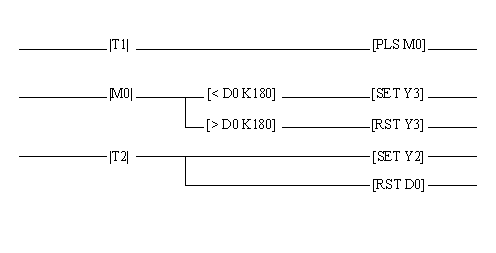
Dick's Resume
Course Offerings
Student Comments
Articles
Step Up To the FX PLC
Poor Man's Analog
Dear Mr. Wizard (Q&A)
PC: History and Tech. Definitions.
What is a PLC
Scan Times V.10
95 Bramble Bush
Springboro, OH 45066
Ph: 937.748.1052
Cell: 513.465.1326
EMail:
Poor Man's Analog
Most PLCs have analog options that give you an accurate conversion of volts or current input to digital value or vice versa. Prices range from $400 to several thousand bucks.
One of the more popular applications for analog is temperature monitor and control using a thermistor as the measuring device. Thermistors are solid state resistors which have a different resistance value with changes in temperature. The resistance change is negative (higher temp equals lower resistance). Unlike the carbon resistor which has a slight positive change. The thermistor change could be over one hundred Ohms. per degree making them an ideal candidate for analog input.
Let's say your boss wants you to control the temp of a drying oven to within ± 2 degrees F at 270°F. You can use software, one spare input, and three spare outputs to do it if you invest about seven bucks in parts.
When you buy a thermistor the device comes with a temp. resistance chart to show the resistance and temp range. Over a short span this relationship will be linear. At 270°F the resistance might be 7,500 Ohms. One degree less, 7645 Ohms. One degree more, 7352 Ohms. A capacitor is first charged via the thermistor in a voltage divider and then discharged into the PLC input. The time it takes the capacitor to discharge down to the threshold level of the input is directly related to thermistor temperature. Here's how it works:
Let's work with 24 volt DC source input and Dry Contact Output.

Output Y1 closes and allows voltage to flow from the voltage divider into the capacitor for 25 seconds. Y1 opens and Y2 closes and at first the input will turn on but as the capacitor discharges the voltage will drop to a point where the input will turn off. The time for X1 on is measured in 10 millisecond increments. The discharge cycle depends on the internal resistance of the input and the voltage that was built up in the cap.
The Logic:

T200 is a 10 millisecond time based Timer. With K1 as the preset value the T200 contact is ticking every 10 ms. as long as T1 and K1 are both not true. The value in D0 starts to build and holds when X1 turns off.

When the T1 contact goes true, M0 is true for one scan. Depending on temperature the oven is turned on (or left on) or turned off (or left off). Y2 is set and the register is reset and ready for another value. This cycle is repeated every 30 seconds.
Where did K180 come from? You will have to experiment to know
the proper value for the set point. It depends on the PLC input module and your
choice of thermistor and capacitor. If you need 0.5% accuracy get a larger
capacitor and increase the cycle time. This will increase the amount of time X1
stays on which will increase the number of ticks, which will put a higher value
in D0. But be careful, you don not want to get too accurate. That might cut into
the sales of $1995.99 analog modules!